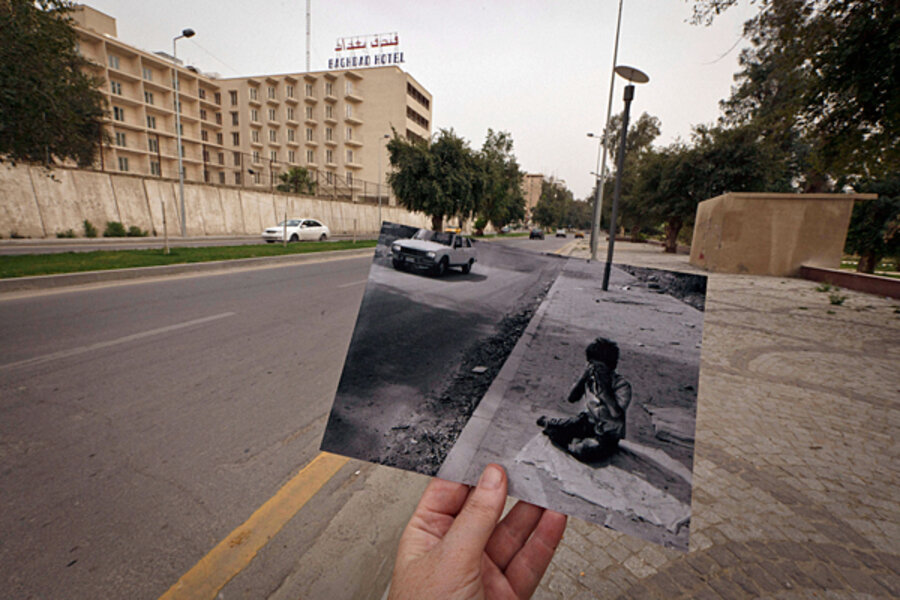Iraq 10 years on: The blast that changed a reporter's view of war
Loading...
Scott Peterson has covered Iraq for the Monitor for more than a decade. This article, which first appeared in March 18 edition of The Christian Science Monitor weekly, is a personal reflection about the day in 2005 when he glimpsed the grim, medium term future for the country's people. A year later he visited with a family who'd lost their home and three family members in the attack and chronicled their struggle to recover – an example of tens of thousands Iraqi families that have gone through the same.
For a long while the Iraq war kept its distance from the enclave centered around Baghdad's Hamra Hotel.
In the prosperous Karada neighborhood, just across the Tigris River from the heavily fortified Green Zone, we Western journalists, along with everyone else, often heard the echo of car bombs; of rockets landing nearby; the rattle of US helicopters on lethal missions passing low overhead. Kidnapping was a growing danger but still a manageable one. Though Iraq had grown more violent each month since the March 2003 US invasion, it was still relatively safe.
At least, it felt that way until one Friday dawn in November 2005, when a double suicide truck bomb tore away any sense that the war was an abstraction afflicting everyone but us.
The blasts threw me out of bed, smashed windows, and tore the doors off their hinges, filling the Monitor bureau with thick dust and building grit – even though our office was tucked in the small Musafir Hotel, shielded from the worst of the blasts by the looming edifice of the Hamra, the main target.
But as I grabbed my cameras and raced for the street, it was immediately clear that the foreigners in the Hamra, the main target, were not the principal victims. It was Iraqi homes and apartments in the neighborhood that suffered the most damage, with houses flattened and lives cut short. Iraqis were pulling dead and wounded from the rubble; cars burned and broken water pipes gushed.
A small girl holding a tiny suitcase screamed in horror, held aloft in the arms of a rescue worker as shouting men loaded victims on stretchers. A bloodied woman in a wheelchair was helped through the debris by two young men.
Tears. Agony. And the uncertainty, loss, and fear that has defined much of the last decade for so many Iraqis. This war has had an incalculable human cost and has scarred every single Iraqi.
At almost any point along the Iraq war timeline, until US troops withdrew completely in December 2011, events brought shock and awe to Iraqis, as their social fabric unraveled more and more.
Torture at Abu Ghraib. The siege of Fallujah. Kidnappings and beheadings. Endless car bombs and suicide attacks. The kidnapping for 83 days of the Monitor's Jill Carroll in 2006. Several local Iraqi Monitor staff or their relatives murdered. Ethnic cleansing in Baghdad that at its peak left 3,000 dead each month – the tortured bodies of many victims dumped on the streets every morning. US killings of civilians at Haditha in Anbar Province. Rape and deaths in Mahmoudiya just south of Baghdad. Morgues overrun by casualties.
Iraqis grew used to this, to the dark forces that seemed to be tearing their world asunder.
And there was resilience, too. I came to know the Methboub family, a widow and her eight children, and saw how they survived amid the violence, falling in and out of love, and coping with it all through well-honed black humor.
Every Iraqi – and indeed every journalist who covered the war – can describe the moment the conflict blasted its way into his or her life. With just under 4,500 American soldiers killed, nearly $1 trillion spent on the Iraq adventure, and credible estimates of Iraqi deaths well into the hundreds of thousands, the occupation, insurgency, and sectarian war was never far away.
For those of us near the Hamra cocoon, one of those moments came that morning in late 2005. The security video showed how easily any sense of invulnerability felt by Iraqis and journalists alike had been wiped away.
It showed a young Iraqi man – son of the Hamra front-desk manager, Salaam – walking home from work at the hotel sweet shop, crossing a security gate at the exact moment that the first truck detonated.
The second truck approached, but in its bid to get through the gap opened up by the first blast it got stuck in the crater and detonated prematurely – saving the hotel from complete destruction, but leveling all the less-robust Iraqi houses in the area.
Years later, after rebuilding – and surviving another bombing in January 2010 – some of the Iraqis in our neighborhood blamed insurgents for the carnage. But many more blamed US forces for not protecting them, as well as Iraqi politicians, whose bickering has created corruption and gridlock.
You hear much the same today, absent the complaints about US troops. Iraq continues to count the trauma of the war years. Sectarian violence remains high.
The foreigners – the reporters, the soldiers – are all but gone.








